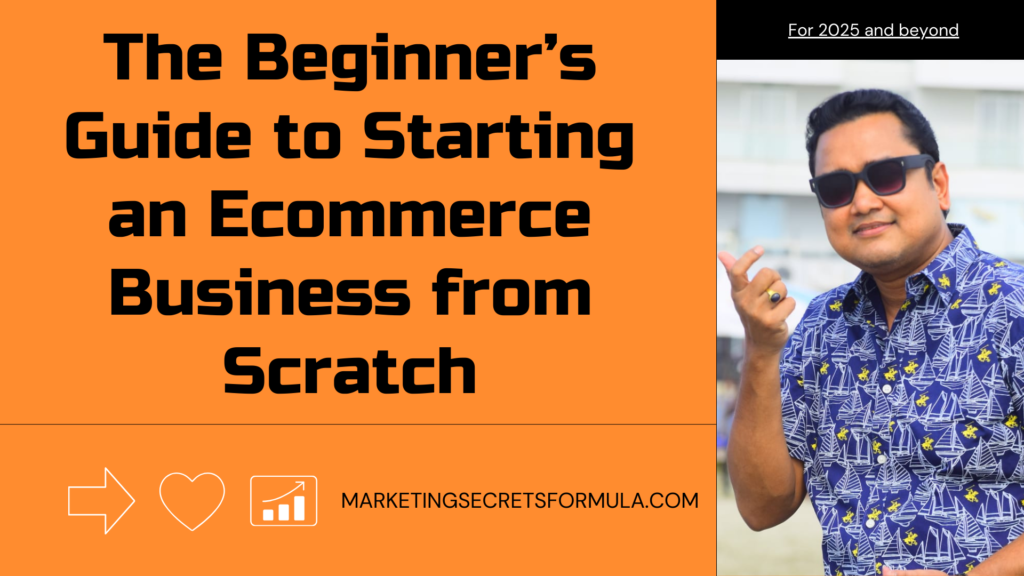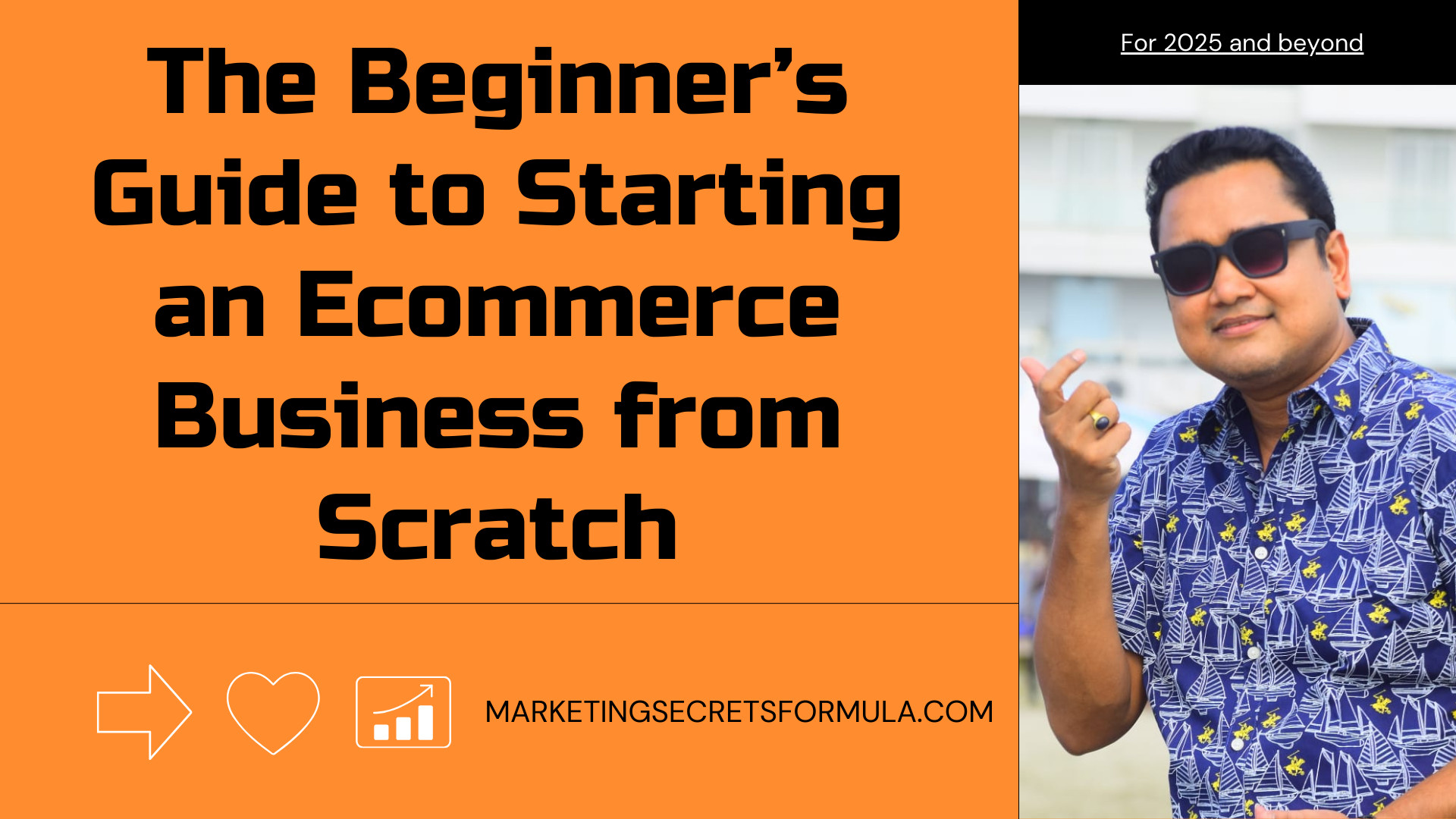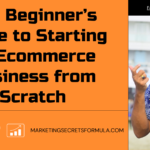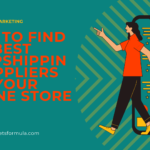Welcome to my article “The Beginner’s Guide to Starting an Ecommerce Business from Scratch” So, you’ve decided to dive into the world of ecommerce? Congrats! You’re about to join the ranks of entrepreneurs who’ve figured out that selling online is not just a trend—it’s a goldmine waiting to be tapped. Whether you’re dreaming of becoming the next Amazon or just want to turn your knitting hobby into a global empire, starting an ecommerce business is like building your own digital kingdom. But let’s be honest, it’s not as simple as slapping up a website and watching the money roll in. If it were, we’d all be sipping piña coladas on private islands by now.
Starting an ecommerce business from scratch may sound intimidating, but don’t worry—you don’t need an MBA or a magic wand to make it happen. It’s all about breaking it down into manageable steps: choosing the right niche (no, selling “everything” isn’t a niche), picking the perfect ecommerce platform, crafting irresistible product listings, and—most importantly—convincing people to click that “Buy Now” button. The good news? You’ve already taken the first step by reading this guide. The bad news? You might find yourself Googling “how to survive sleepless nights as an entrepreneur” at some point.
But fear not! In this guide, we’ll walk you through every step of the process with tips, tools, and maybe even a sprinkle of humor to keep things light. By the end, you’ll have a clear roadmap to launching your online store and a newfound confidence that you can totally crush this ecommerce game. Ready to trade the 9-to-5 grind for the freedom of online business? Let’s get started!
Access My Proven Tested Formula for $50-$100 Daily Income – Watch This FREE Video Now >>>

Research and Plan Your Ecommerce Business
Before you dive into building your online store, let’s tackle the less glamorous but absolutely crucial part: research and planning. Think of this step as creating the blueprint for your ecommerce empire—because, let’s face it, even the fanciest castles crumble without a solid foundation.
Define Your Niche: Don’t Be a Jack of All Trades
Let’s start with the golden rule of ecommerce: you can’t sell everything to everyone. Sure, Amazon does it, but you’re not Amazon (yet). Finding your niche means zeroing in on a specific audience with a particular need. For example, instead of selling generic pet products, focus on premium accessories for dogs that secretly think they’re royalty (yes, dog tiaras are a thing).
Ask yourself: What problems can I solve for my customers? Is there a market for it? A great niche is profitable, specific, and aligns with your interests—because selling something you’re passionate about beats hawking widgets you can’t even pronounce.
Conduct Market Research: Stalking, But Make It Legal
Once you’ve chosen a niche, it’s time to put on your detective hat. Research your competition to see what they’re doing right—and where they’re missing the mark. Use tools like SEMrush, Ubersuggest, or Google Trends to analyze keywords, customer behavior, and trends.
Pay attention to things like pricing, customer reviews, and product offerings. This isn’t just about copying your competitors but finding ways to do it better. Think faster shipping, better packaging, or offering that one product feature no one else has thought of.
Create a Business Plan: Your Ecommerce GPS
A business plan may sound like a task reserved for corporate bigwigs, but it’s essential—even for a one-person operation. This document doesn’t need to be a 50-page novel. Keep it simple:
- Your Goals: What do you want to achieve in the first 6 months? The first year?
- Your Budget: How much can you realistically invest without maxing out your credit card?
- Your Pricing Strategy: Are you going for luxury, budget-friendly, or somewhere in between?
- Your Target Audience: Who are they, and where do they hang out online?
Think of your business plan as your ecommerce GPS. Without it, you’ll be wandering in circles wondering why no one’s buying your artisanal cat sweaters.
Would you like me to expand on other sections or continue with a specific tone?
Choose the Right Ecommerce Platform
Once you’ve done your research and know what you want to sell, it’s time to set up shop—or, in this case, your online storefront. But here’s the kicker: choosing the right ecommerce platform is like picking a life partner. It’s a big decision, and you want to make sure it’ll stick around for the long haul without crashing on you in the middle of a Black Friday sale.
Let’s break this down so you can swipe right on the perfect platform for your business.
Compare Popular Platforms: The Good, the Bad, and the Expensive
Ecommerce platforms come in all shapes, sizes, and price tags, so it’s important to choose one that fits your needs like a glove. Here’s a quick rundown of the top contenders:
- Shopify: The golden child of ecommerce platforms. It’s user-friendly, comes with tons of integrations, and offers great customer support. The catch? Monthly fees can add up, especially if you start stacking on paid apps like they’re Pokémon cards.
- WooCommerce: The DIY option for those who already have a WordPress site (or are willing to learn). It’s super customizable and free to start, but you’ll need to handle hosting, plugins, and the occasional tech hiccup.
- BigCommerce: Great for scalability, with plenty of built-in features that eliminate the need for too many apps. However, it can feel a bit clunky for beginners.
- Squarespace: Ideal for creatives and small businesses with simple needs. It’s visually stunning but lacks the advanced ecommerce tools of other platforms.
Pro tip: Take advantage of free trials to test out a few platforms before committing. It’s like speed dating but with less awkward small talk.
Access My Proven Tested Formula for $50-$100 Daily Income – Watch This FREE Video Now >>>
Domain Name and Hosting: Your Online Store’s Curb Appeal
Your domain name is your ecommerce business’s first impression—so don’t mess it up. Ideally, it should be:
- Memorable: Nobody wants to type www.awesomecoolshop34291.com.
- SEO-Friendly: Include relevant keywords without going overboard. “BestYogaMats.com” is great; “SuperLongNameThatGoogleHates.com” is not.
- Brand-Appropriate: Make it unique and aligned with your niche.
After nailing the perfect name, you’ll need a reliable hosting provider to ensure your store runs smoothly. Slow-loading websites are the online equivalent of a checkout line that moves at snail speed. Nobody has the patience for it, so invest in quality hosting—your customers (and your Google rankings) will thank you.
Set Up Your Online Store: The Fun Part
Once you’ve picked your platform and secured your domain, it’s time to build your store. Here’s where the magic happens:
- Choose a Theme: Most platforms offer free and paid themes to give your store a professional look. Pick one that’s visually appealing and easy to navigate (because nobody likes getting lost on a website).
- Add Essential Plugins and Features: Think email capture tools, SEO plugins, and payment gateways. These are the bells and whistles that keep your store running like a well-oiled machine.
- Customize Your Storefront: Add your logo, brand colors, and images to create a cohesive brand identity. Pro tip: Invest in professional photos or use high-quality stock images—blurry photos scream “amateur hour.”
- Optimize for Mobile: With over half of online shoppers browsing on their phones, a mobile-friendly design isn’t optional. Test your site on multiple devices to make sure it looks great everywhere.
Choosing the right ecommerce platform isn’t just about what works today—it’s about setting yourself up for long-term success. Take the time to weigh your options, and remember: your platform should grow with your business, not hold you back.
Need help deciding? Just imagine explaining your choice to a skeptical friend. If you can confidently say, “This platform is the Beyoncé of ecommerce,” then you’re on the right track.
Would you like me to expand on the next topic or tweak any part of this?
Build a Winning Product and Marketing Strategy
Alright, you’ve got your ecommerce platform set up, your virtual doors are open, and your brand-new domain is ready to wow the internet. But let’s not get ahead of ourselves—if you don’t have a solid product and marketing strategy, your store could be as quiet as a library on a Monday morning. A winning strategy is what turns window shoppers into loyal customers and “meh” sales into cha-chings! Here’s how to make your products and marketing work together like peanut butter and jelly.
Choose Products People Actually Want (Not Just What You Think They Want)
First things first: your product lineup is the backbone of your business. Even the slickest marketing campaign can’t save a store filled with stuff no one wants. Here’s how to nail it:
- Solve a Problem or Fulfill a Desire: Whether it’s a product that fixes a common annoyance (hello, self-cleaning water bottles) or one that taps into a trend (goodbye, fidget spinners), make sure your offerings are relevant to your target audience.
- Test the Waters: Not sure if a product will sell? Start small. Use platforms like Etsy or eBay to test demand before investing heavily in inventory.
- Keep Quality in Check: Repeat after me: A good product sells itself. Customers will forgive many things, but low-quality products aren’t one of them.
- Stand Out from Competitors: Add a unique spin to your products, whether it’s eco-friendly packaging, personalized options, or even a quirky brand story. Differentiate or die trying.
Craft a Killer Marketing Strategy: It’s Showtime
Even the most amazing products need a little marketing magic to find their way into customers’ carts. Luckily, we’re living in the golden age of digital marketing, where creativity and strategy are your best friends.
- Leverage Social Media:
Pick platforms where your target audience hangs out. Selling to millennials? Instagram and TikTok are your playgrounds. Catering to professionals? LinkedIn could be your goldmine. Pro tip: Don’t just post product photos; share behind-the-scenes content, user testimonials, and even memes that fit your brand voice. Nobody scrolls past a good meme. - Use Email Marketing (Yes, It’s Still Relevant):
Build an email list from day one. Offer something valuable—like a discount or a free guide—to encourage signups. Then, send regular (but not annoying) updates featuring new arrivals, sales, or tips that align with your products. - Partner with Influencers:
No, you don’t need to hire someone with 10 million followers. Micro-influencers (those with smaller but highly engaged audiences) can help spread the word to the right crowd. Make sure they align with your brand—nobody wants to see a fitness influencer promoting donuts (unless it’s ironic). - SEO and Content Marketing:
The best marketing strategies are the ones that keep working even when you’re asleep. Optimize your product pages with keywords your audience is searching for, and create helpful blog posts or videos to drive traffic to your store. For example, if you’re selling skincare, a blog titled “10 Tips for Glowing Skin” can subtly plug your products while offering value.
Pricing That’s Smart, Not Random
Pricing isn’t just a numbers game; it’s a psychology game. Set your prices too high, and you’ll scare customers away. Too low, and you’ll leave money on the table (or worse, look cheap).
- Research Competitors: Check out what others in your niche are charging and position your pricing accordingly.
- Offer Discounts Strategically: Everyone loves a good sale, but don’t make it a habit, or your customers will wait for discounts instead of buying full price.
- Use Charm Pricing: $19.99 sounds way more appealing than $20, right? It’s a classic trick that still works.
Analyze, Adjust, and Repeat
Your strategy isn’t something you set and forget—it’s a living, breathing thing. Use analytics tools to track what’s working and what isn’t. Are certain products flying off the shelves while others gather dust? Is your social media engagement through the roof, but your email campaigns flatlining? Adjust as needed.
A winning product and marketing strategy is all about understanding your audience, staying flexible, and being consistent. And remember: even if things don’t go as planned at first, every big success story starts with a few hiccups. Just keep learning, tweaking, and growing.
Would you like me to expand on customer engagement strategies or add some real-world examples?
Launch and Grow Your Ecommerce Business
The moment has finally arrived—you’re ready to launch your ecommerce business! But before you pop the champagne, remember: launching is just the beginning. The real magic happens in how you grow, adapt, and keep those sales rolling in. Think of it like planting a garden—you’ve tilled the soil, sown the seeds, and now it’s time to water, weed, and watch it thrive. Let’s break it down.
Step 1: Make a Grand Entrance (Without Breaking the Internet)
Launching your store isn’t just about hitting the “publish” button—it’s about creating buzz and excitement. Here’s how to ensure your debut gets noticed:
- Soft Launch vs. Big Launch: Not sure everything’s perfect yet? Start with a soft launch for a small group of friends, family, or early adopters. It’s a great way to gather feedback before going all out. When you’re confident, crank up the volume with a big launch announcement.
- Use Social Media Hype: Build anticipation by teasing your launch on social media. Post sneak peeks of your products, behind-the-scenes setup shots, or a countdown. Bonus points if you throw in a giveaway or exclusive launch discount—it’s irresistible!
- Collaborate with Influencers: Partner with influencers in your niche to promote your launch. Their audience trust can give you a head start.
- Email Your List: Remember that email list you built? Send a launch announcement with a special offer for your subscribers—they’ll feel like VIPs.
Access My Proven Tested Formula for $50-$100 Daily Income – Watch This FREE Video Now >>>
Step 2: Create a Stellar Customer Experience
Congrats, you’ve got traffic! But don’t pop that second bottle of champagne yet—your customers’ experience will make or break your business. Aim to impress them every step of the way.
- User-Friendly Website: Make sure your site is easy to navigate. Test everything—from product search to checkout—because nothing kills excitement faster than a confusing shopping cart.
- Fast Shipping: In the age of two-day delivery, customers don’t want to wait a week for their orders. Partner with reliable shipping services or consider options like dropshipping to speed things up.
- Excellent Customer Support: Be ready to answer questions, handle complaints, and go the extra mile. Chatbots are great, but real human help? Even better.
Step 3: Track Your Progress Like a Pro
Data is your new best friend. Use analytics tools to track your store’s performance and customer behavior. It’s not just numbers—it’s a treasure map pointing you toward growth opportunities.
- Track Sales and Traffic: Use tools like Google Analytics to see where your visitors are coming from and which products are driving sales.
- Monitor Customer Feedback: Check reviews, social media comments, and direct messages to see what people love (and what they don’t). Use this feedback to improve.
- A/B Testing: Try different headlines, product photos, or call-to-action buttons to see what resonates best with your audience. Small tweaks can lead to big results.
Step 4: Keep Marketing, Always
Launching is a one-time event, but marketing? That’s your forever job. Don’t rest on your laurels—keep promoting your business to stay top-of-mind.
- Run Paid Ads: Platforms like Facebook, Google, and Instagram offer targeted ads that reach your ideal audience. Start small, track results, and scale up what works.
- Content Marketing: Create blog posts, videos, or social media content that adds value to your customers’ lives while subtly promoting your products.
- Email Campaigns: Use emails to announce new products, share helpful tips, or remind customers about items they left in their carts. The occasional discount email doesn’t hurt either.
- Retargeting Ads: Bring back visitors who browsed but didn’t buy. Sometimes people just need a little nudge (or a discount code) to make up their minds.
Step 5: Focus on Growth Strategies
Ready to level up? Here are some strategies to help your business grow like wildfire:
- Expand Your Product Line: Once your initial products are selling well, consider adding complementary items. For example, if you sell yoga mats, why not add yoga blocks, water bottles, or instructional videos?
- Enter New Markets: Ship internationally, or target new customer demographics. Expanding your reach can open up huge opportunities.
- Build a Loyalty Program: Reward repeat customers with points, discounts, or exclusive perks. Happy customers are your best brand ambassadors.
- Collaborate with Other Brands: Partner with businesses that complement your products. Cross-promotions can bring in a whole new audience.
Celebrate Milestones (and Stay Resilient)
Growth takes time, so don’t forget to celebrate the wins—big or small. First sale? Pop a cupcake. First 1,000 visitors? Break out the party hats. But also remember, challenges will come. Learn from mistakes, adapt, and keep going.
Launching and growing an ecommerce business is a marathon, not a sprint. With dedication, smart strategies, and a dash of creativity, you’ll be on your way to turning your online store into a thriving success story. And who knows? Maybe someday you’ll look back and laugh at how nervous you were to hit that “launch” button.
Would you like help expanding on specific growth strategies or a deeper dive into marketing tactics?
Conclusion: You’re Ready to Conquer the Ecommerce World
And there you have it—your ultimate guide to starting an ecommerce business from scratch! You’ve gone from that “Where do I even begin?” moment to understanding how to plan, launch, and grow your dream business. Sure, the road ahead might have a few speed bumps (we’re looking at you, website glitches and supply chain hiccups), but you’re now armed with the knowledge to handle them like a pro.
Remember, starting an ecommerce business isn’t about overnight success—it’s about consistency, creativity, and a sprinkle of grit. You don’t need to have all the answers right away (spoiler: nobody does). What you do need is a commitment to learning as you go and adapting to the ever-evolving online marketplace. Whether it’s perfecting your product lineup, tweaking your marketing campaigns, or diving into analytics, every step you take gets you closer to ecommerce glory.
So, take a deep breath, pat yourself on the back for all the hard work, and start turning your vision into reality. Yes, there will be challenges, but there will also be wins—big and small—that remind you why you started this journey in the first place. Whether you’re building a side hustle or aiming for the next big thing in ecommerce, the key is to keep moving forward.
Access My Proven Tested Formula for $50-$100 Daily Income – Watch This FREE Video Now >>>
And who knows? A few months from now, you might just find yourself sipping coffee, watching the sales roll in, and wondering why you didn’t start sooner. Now go out there and make the internet your storefront! The ecommerce world is waiting for you.
Would you like me to add some motivational takeaways or tips to wrap things up even more powerfully?
Thanks a lot for reading my article on “The Beginner’s Guide to Starting an Ecommerce Business from Scratch” till the end. Hope you’ve helped. See you with another article.










